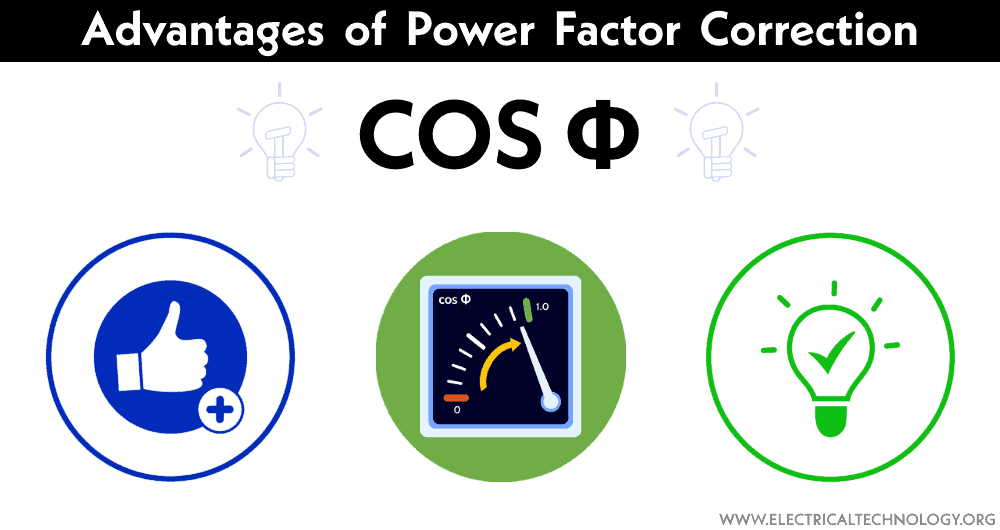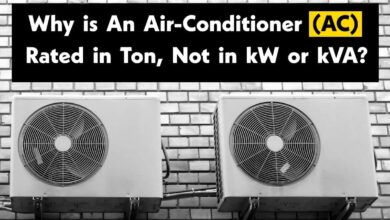Advantages of Power Factor Improvement and Correction
Advantages of Improved Power Factor
Power factor improvement and correction refer to the process of increasing the power factor of an electrical system by reducing the reactive power consumption. This can be achieved through various methods such as installing power factor correction capacitors, using synchronous motors, static VAR compensator, phase advancer or improving the design of the electrical system. Power factor improvement and correction can have several advantages, including:
- Increased Efficiency: Power factor correction reduces the amount of reactive power in the system, which results in a decrease in the total power required from the utility. It means, less amount of energy is used which helps to reduce the electric bills.
- Reduced Voltage Drop: Low power factor can cause voltage drops, which can lead to equipment damage, reduced equipment life, and poor system performance. Power factor correction helps reduce voltage drops, leading to improved system performance and equipment life.
- Small Size Conductor: Improving the power factor leads to a reduction in the size of the conductor, resulting in lower copper costs for cables and wires.
- Reduced Line Losses: PF improvement helps to reduce the I2R A.K.A line losses or copper losses.
- Small Size of Machines: Electrical machines, such as motors, transformers, and generators, are appropriately sized and smaller in a high power factor designs. As the size of appliances and devices would be larger in the low power factor environment due to the more current and inefficiency of the system.
- Low kWh Needed: Lesser kWh is needed to operate the same appliance with improved PF.
- Saving in Power Bills: The correct PF improves the overall efficiency of the electrical system, reduces energy losses and lowers electricity bills.
- Reduced Cost: Improving power factor results in energy savings and reduced costs of electrical devices and equipment due to the increased efficiency of the system. This includes lower ratings and reduced energy consumption for the same level of output, which translates to lower operating costs and improved economic performance.
- Power Capacity Optimization: Power factor correction can help optimize the capacity of the electrical system. A higher power factor means that more active power can be delivered with the same amount of apparent power. This allows the system to handle more loads and reduces the risk of overloading (in the lines and generator), leading to improved system performance and reliability.
- Compliance with Utility Requirements: Utility companies often impose penalties on consumers for low power factor. Power factor correction helps ensure compliance with utility requirements and reduces the risk of penalties.
- Environmental Benefits: Power factor correction reduces the amount of energy required to run electrical equipment, which results in a reduction in greenhouse gas emissions. This makes power factor correction an environmentally-friendly solution for reducing energy consumption.
In conclusion, power factor improvement offer several advantages, including increased efficiency, capacity optimization, reduced voltage drop, compliance with utility requirements, low kWh and power bills, and environmental benefits. Investing in power factor correction can help improve the performance and reliability of electrical systems, while also reducing energy consumption and associated costs.
Related Posts:
- What is Power Factor?
- Active, Reactive, Apparent and Complex Power
- Difference Between Active and Reactive Power – Watts vs VA
- Causes of Low Power Factor
- Power Factor improvement Methods with Their advantages & Disadvantages
- Disadvantages of Low Power Factor
- How to Calculate the Suitable Capacitor Size in µ-Farads & kVAR for P.F Improvement
- How to Convert Capacitor μ-Farads to kVAR and Vice Versa? – For P.F Correction
- Capacitor Bank in kVAR & µF Calculator for Power Factor Correction
- Power Factor Correction Calculator – How to Find P.F Capacitor in µF & kVAR?
- kVAR to Farad Calculator – How to Convert kVAR to μ-Farads?
- μ-Farad to kVAR Calculator – How to Convert Farads to kVAR?
- Analysis of Reactive Power in Power System
- Is Reactive Power Useful? Importance of Reactive Power
- Introduction of Custom Power Devices For Power Quality Improvement
- What is Static VAR Compensator (SVC)? Construction, Working and Applicators








Please tell me if power factor protect electronic advice from sudden over voltage ?
Thank you for the info.